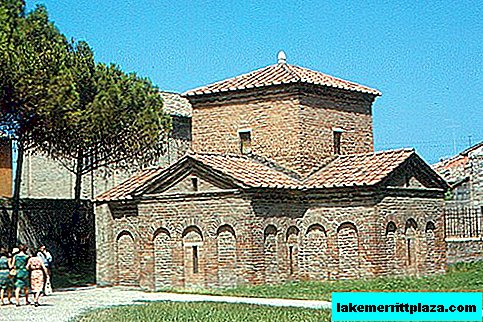Ravenna is a rather quiet and cozy town in the Emilia-Romagna region, who managed to visit the capital several times - first the Roman Empire, then the Ostrogoth state, as well as the Landgobar kingdom and the Ravenna exarchate. Each regular ruler tried to celebrate his presence with the construction of new palaces and temples, as well as the decoration of existing ones, which made Ravenna one of the main centers of Italian architectural and mosaic art.
Once Ravenna was a rather significant military port, but over time the Adriatic Sea receded and now the city and the sea are connected only by a ten-kilometer canal.

Ravenna has become a source of inspiration for many writers and poets
The magnificent Ravenna has become a source of inspiration for many writers and poets, it is mentioned in their works Byron, Goethe, Oscar Wilde, Blok. Dante, the author of the famous Divine Comedy, spent the last years of his life here.
Mausoleum of Galla Placidia
The main attraction of Ravenna - The mausoleum of Galla Placidia, - the oldest urban building dating from the beginning of the V century. In fact, this building is not a real mausoleum, since it is reliably known that Galla Placidia, the daughter of the great emperor Theodosius, was buried in Rome, and the mausoleum was a chapel at the church of the palace of San Croce, built in honor of the holy martyr Lawrence - the patron saint of the emperor's family.

Outside, the mausoleum looks inconspicuous and looks more like a small fortress
Outside, the mausoleum is a nondescript structure, similar to a small fortress - powerful thick walls, narrow windows resembling embrasures. But the interior is striking in its splendor, especially in contrast to the modest appearance - the walls and arches of the room are decorated with ancient mosaics depicting Christ in the form of a good shepherd, St. Lawrence, the apostles, as well as animals, birds, elegant flowers and plants.
On the dome arch you can see a delightful mosaic ornament on a dark blue background, familiar to many from the images on scarves, panels, postcards and other souvenirs from Ravenna. Famous doves drinking from a bowl, often found on local souvenirs, also come from here.
In clear weather, when the rays of the sun penetrate through narrow windows, the walls of the mausoleum seem lined with precious stones - smalt cubes, of which mosaics are laid, magically shine in the sun.

Under the dome of the Galla Placidia Mausoleum - a mosaic ornament familiar to many
The mausoleum of Galla Placidia is under the protection of UNESCO as a World Heritage Site.
The visit to the mausoleum is limited, because the interior is small, and the stream of people who want to admire the stunning mosaics does not dry out: each visitor can spend no more than ten minutes inside.
Cheap hotels in Ravenna
A few steps from the mausoleum of Galla Placidia is the four-star Hotel Bisanzio, in which tourists who plan to devote a vacation to exploring the historical sights of the city like to stay. Convenient and comfortable rooms are located in a recently renovated historic building, surrounded by a small quiet park.
Those traveling by car or planning to rent a car should be aware that the hotel is in a pedestrian zone, so you will have to walk to the nearest car park.

Hotel Bisanzio is located close to the historic sites of Ravenna
In the historical center of the city, a five-minute walk from the mausoleum is located a small cozy hotel Sant'Andrea - it is very convenient to use it as a base for visiting mosaic sights of Ravennawithin walking distance. After strolling around the city, guests can comfortably relax in the beautiful garden adjacent to this hotel.
The elegant Santa Maria in Foris is located about three hundred meters from the Galla Placidia Mausoleum. The stylish and comfortable rooms have TVs and air conditioning, a separate bath or shower, some bathtubs are equipped with hydromassage.

Hotel Santa Maria in Foris is located three hundred meters from the Galla Placidia Mausoleum
Hotel guests are offered daily breakfasts - in summer they are served in the garden or on the terrace, in the cold season - in the dining room or directly in the room.
Of course the choice Hotels in Ravenna much wider than the format of this article allows. A detailed list of them, with descriptions, photos and guest reviews can be viewed here. If desired, here, you can instantly book your favorite option.
Other attractions of Ravenna
The main attractions of Ravenna are located quite compactly - in the historical center of the city. Next to the mausoleum of Galla Placidia rises the building of the Basilica of San Vitale - a well-preserved example of Byzantine architectural art of the VI century.
The main artistic value of St. Vitaly’s Cathedral is the mosaic portraits of Emperor Theodore and his wife, made during the emperor’s life, as well as mosaics depicting biblical scenes.
Not far from the basilica is the National Museum, famous for its extensive collection of Roman coins, ancient weapons and interesting ivory carvings.

The main value of St. Vitaly Cathedral - mosaic portraits
Heading east from the Basilica of San Vitale, you will find yourself in the Arian Baptistery, built at the beginning of the VI century. The Baptistery is an octagonal building with thick walls lined with burnt bricks. The interior of the baptistery is decorated with mosaics depicting the baptism of Christ and the apostles.
In the southern part of the city is the Cathedral Square with the Cathedral, built in the IV century, and then rebuilt several times. In the cathedral you can see several surviving works of the early Christian period - ancient sarcophagi, marble pulpit, painted by the artist Guido Reni lunette.
Here, on Cathedral Square, the Orthodox Baptistery is located - a simple brick building, the interior of which is decorated with magnificent mosaics that resemble images in the mausoleum of Galla Placidia.

The mausoleum of King Theodorich the Great was built by him in 520.
All tourists are certainly trying to visit the grave of Dante - a specially built tomb, resembling in its shape a temple with a small dome, in the center of which stands a marble sarcophagus with the remains of a poet. Of considerable interest to tourists are the Mausoleum of Theodoric, the Cathedral of the Holy Spirit, the Brancaleone fortress.








